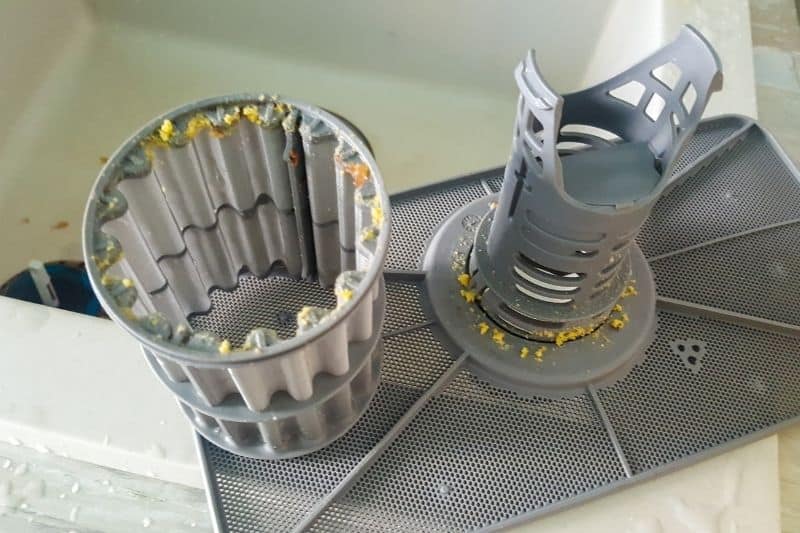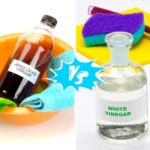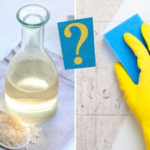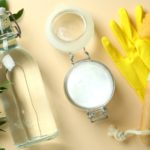Dishwashers are a lifesaver appliance, especially in my household. Without adequate care, however, a dishwasher can quickly build up grime, dirt, mould, and bacteria.
Scrubbing every surface of the machine with soap and water is of course possible, however, this can be tedious and incredibly inefficient.
You could purchase a purpose-designed dishwasher cleaner, or you can use the household staples that are white vinegar and bicarbonate of soda.
How to Clean a Dishwasher With Vinegar
First things first – gather your supplies. To best clean your dishwasher with vinegar, you will need:
- Warm water
- Distilled white vinegar
- Bicarbonate of soda
- Toothpick (or just something pointy)
- An old toothbrush or nail brush
- Cloth
I would also recommend wearing rubber gloves for this process. Vinegar might be non-toxic and gentle but cleaning the inside of a dishwasher can be a really gross chore.
Step 1: Take Out Anything Removable
Once the dishwasher is empty, the first thing you will need to do is take out everything removable. Think racks, utensil holders, filters, the works. All of these parts will need to be properly cleaned before you proceed.

Fill the sink (or a large container) with a mixture of warm water and a cup of white vinegar. Leave the utensil holders, filters, and other small items to soak in the mixture for at least thirty minutes.
For the larger items such as the racks, wipe the surfaces down with the same water and vinegar mixture.
Step 2: Clear up debris
Whilst everything is soaking, check the rest of the dishwasher for debris and large chunks of food that might be still present.
Wipe the sidewalls, paying close attention to the corners of the machine.
Remove the spray arms and wipe them over with a mixture of vinegar and warm water. If there is food caught in the tiny holes, you need to clear this out; this is where the toothpick comes in.
Once any debris has been cleared away, replace the filters, spray arms, racks, and anything else you removed.
Step 3: Vinegar
Fill a dishwasher-safe bowl or container with a cup of white vinegar and set it in the bottom rack of the machine. Run the dishwasher on a hot cycle.
The combination of the acidic vinegar and the hot water will break down any food, grease, residue, and other nasties.
Step 4: Bicarbonate of soda
Once the vinegar cycle ends, take out the bowl and sprinkle a cup of bicarbonate of soda along the bottom surface of the dishwasher.
Run the machine again. If you have one, you can use a shorter cycle this time around. The bicarbonate of soda will get rid of any straggler smells that remain and leave you with a shiny and fresh dishwasher.
Step 5: Surfaces
The outside of the dishwasher’s door can end up covered in food splatters easily, and whilst you’re here, you might as well deal with that too.
It is important to use a cleaning method that is designed for your dishwasher’s construction, for example, if the machine is stainless steel, you want a product that is made for cleaning stainless steel.

Alternatively, you can create a homemade cleaning mixture that will work great no matter the surface. Mix washing up liquid, water, and white vinegar in a spray bottle, and use this with a microfibre cloth to clean the outer surfaces and the control panel.
Step 6: The seal
Food and grime can gather on the seal and get caught in the folds so easily. To deal with this, dip a clean cloth in a mixture of warm water and white vinegar, and wipe over the surfaces.
If you cannot easily access the inner folds of the seal, consider using an old toothbrush or cotton buds dipped in the vinegar mixture to get in the creases.
Top Tips
Before getting started using vinegar to clean your dishwasher, here are just a few tips that you should consider
Types of vinegar
Whilst every type of vinegar that you could use is acidic and so technically could work, you will achieve much better results with distilled white vinegar.
White vinegar is the best choice as it doesn’t contain any colouring agents and so will not stain light-coloured surfaces, and its acidity level is like that found in many multipurpose cleaners. As an added benefit, it doesn’t smell quite as strong as some other kinds of vinegar too.
Smell
Some people may find themselves put off using vinegar as a natural cleaning agent because of the smell. This can be easily dealt with by adding a couple of drops of essential oil to the vinegar when you add it to the dishwasher.
Routine cleaning
For best results, you should aim to clean the inside of your dishwasher once a month, and the low-cost, non-toxic nature of vinegar means you can use vinegar every time.
Benefits of Using Vinegar
White vinegar is a much gentler cleaning solution than many commercially available products. Vinegar is non-toxic, eco-friendly, and super affordable, whilst a lot of commercial cleaning agents are irritants and are bad for the environment.
Vinegar can also kill some pathogens and certain bacteria, including some common household strains, such as E. coli. As a result, the inside of a typical dishwasher can be cleaned with white vinegar and hot water.
However, if the dishwasher has been sitting for a long time without use, you may need to use something stronger to deal with the bacteria.

Lover of coffee, painting, and all things cute and fluffy. I’m always on the lookout for easier, more gentle ways to tackle awful household chores.






